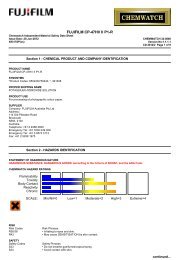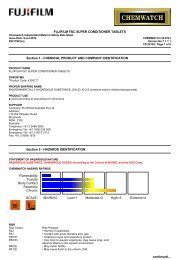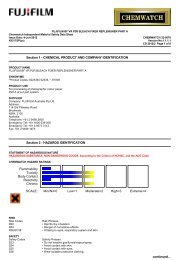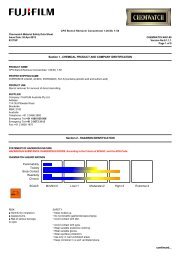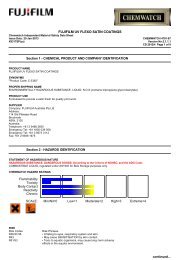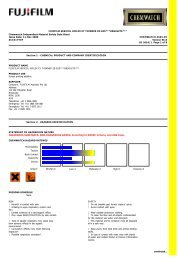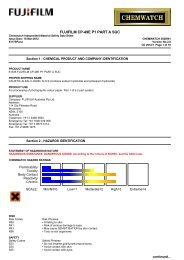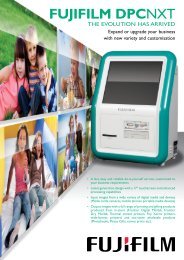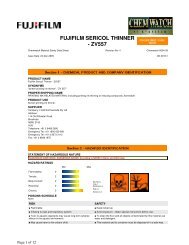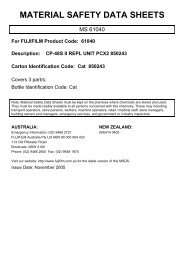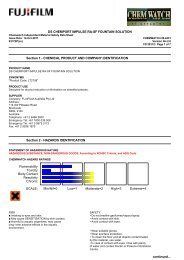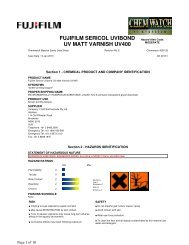Chemwatch Australian MSDS 31-8731 - FUJIFILM Australia
Chemwatch Australian MSDS 31-8731 - FUJIFILM Australia
Chemwatch Australian MSDS 31-8731 - FUJIFILM Australia
You also want an ePaper? Increase the reach of your titles
YUMPU automatically turns print PDFs into web optimized ePapers that Google loves.
<strong>FUJIFILM</strong> CN-16Q NQ3-RS<br />
<strong>Chemwatch</strong> Independent Material Safety Data Sheet<br />
Issue Date: 7-May-2012 CHEMWATCH <strong>31</strong>-87<strong>31</strong><br />
X9<strong>31</strong>7SP(cs)<br />
Version No:2.0<br />
CD 2012/2 Page 3 of 8<br />
Section 5 - FIRE FIGHTING MEASURES<br />
EXTINGUISHING MEDIA<br />
• There is no restriction on the type of extinguisher which may be used.<br />
• Use extinguishing media suitable for surrounding area.<br />
FIRE FIGHTING<br />
• Alert Fire Brigade and tell them location and nature of hazard.<br />
• Wear breathing apparatus plus protective gloves in the event of a fire.<br />
• Prevent, by any means available, spillage from entering drains or water courses.<br />
• Use fire fighting procedures suitable for surrounding area.<br />
FIRE/EXPLOSION HAZARD<br />
• Non combustible.<br />
• Not considered a significant fire risk, however containers may burn.<br />
Decomposition may produce toxic fumes of: nitrogen oxides (NOx), sulfur oxides (SOx).<br />
May emit poisonous fumes.<br />
FIRE INCOMPATIBILITY<br />
■ None known.<br />
HAZCHEM<br />
None<br />
Section 6 - ACCIDENTAL RELEASE MEASURES<br />
MINOR SPILLS<br />
• Clean up all spills immediately.<br />
• Avoid breathing vapours and contact with skin and eyes.<br />
• Control personal contact with the substance, by using protective equipment.<br />
• Contain and absorb spill with sand, earth, inert material or vermiculite.<br />
MAJOR SPILLS<br />
■ Moderate hazard.<br />
• Clear area of personnel and move upwind.<br />
• Alert Fire Brigade and tell them location and nature of hazard.<br />
• Wear breathing apparatus plus protective gloves.<br />
• Prevent, by any means available, spillage from entering drains or water course.<br />
Personal Protective Equipment advice is contained in Section 8 of the <strong>MSDS</strong>.<br />
Section 7 - HANDLING AND STORAGE<br />
PROCEDURE FOR HANDLING<br />
• DO NOT allow clothing wet with material to stay in contact with skin.<br />
• Avoid all personal contact, including inhalation.<br />
• Wear protective clothing when risk of exposure occurs.<br />
• Use in a well-ventilated area.<br />
• Prevent concentration in hollows and sumps.<br />
SUITABLE CONTAINER<br />
• Polyethylene or polypropylene container.<br />
• Packing as recommended by manufacturer.<br />
• Check all containers are clearly labelled and free from leaks.<br />
STORAGE INCOMPATIBILITY<br />
■ For inorganic thiosulfates<br />
• Avoid storage with acids, metal nitrites, sodium nitrite, halogens and oxidizing agents.<br />
• Forms explosive product with potassium nitrate, sodium nitrate<br />
• Reacts with acids, forming sulfur dioxide<br />
• Incompatible with halogens, lead, silver and mercury salts. iodine.<br />
• Inorganic reducing agents react with oxidizing agents to generate heat and products that may be flammable, combustible, or<br />
otherwise reactive. Their reactions with oxidizing agents may be violent.<br />
• Incidents involving interaction of active oxidants and reducing agents, either by design or accident, are usually very<br />
continued...



